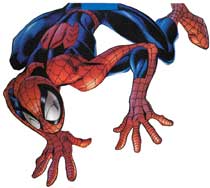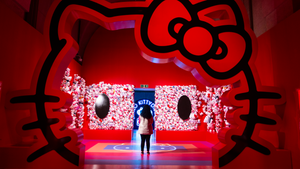]> By Robert Scally<br><br>At the movies and in the mall, traditional titles take on new power Comics and licensing were made for each other. Fantastic
April 6, 2018

]>
By Robert Scally<br><br>At the movies and in the mall, traditional titles take on new power

Comics and licensing were made for each other. Fantastic characters inhabiting alternate realities leap from the pages of comic books and into the realm of licensed consumer products with relative elán.
"There's a long history behind it," explains Cheryl Rubin, VP, licensing and merchandising, DC Comics (New York). "Comic books have inspired media licensing and merchandising programs almost since they first started."
Why? "Comic books tell great stories, they invent new characters and create new worlds that people can relate to."
Supernatural licensing from the house of DC
DC's Superman was one of the first major comic book character licenses, spawning numerous consumer products in the late 1930s and 1940s. The merchandising program supported the Superman comic strips and comic books, and those publishing products in turn were the base for advertising the toys, gizmos, lunch pails, and apparel that flowed into retail stores.
"It was a true phenomenon," Rubin comments.
Since Superman's first flights of brand-extension fancy, the character has appeared in movie serials and feature films, on Broadway, and in both live action and animated TV shows. The Man of Steel is arguably the most recognizable comic book superhero.
DC stable-mate Batman has followed much the same media arc as Superman, culminating with the first Batman feature film released by Warner Bros., in 1989, which itself spurred a multi-hundred-million dollar tide of merchandising.
Among the latest DC mutations are the current live action TV series Smallville - which builds on the story of Superman's youth - and the Batman comic book title The Dark Knight Strikes Again, written and drawn by noted comics creator Frank Miller.
The Superman "S" logo has also remained popular through the years and is currently a favorite of tween and teen girls.
"When a girl wears the red "S" logo on a T-shirt," remarks Rubin, "she feels empowered."
DC, an AOL-Time Warner subsidiary, recently licensed a line of Supergirl lingerie to SBH Holdings (New York). The Supergirl line will include underwear, loungewear, lingerie and bras.
Supergirl lingerie? Just another demonstration of how core, evergreen characters can appeal to consumers ranging from graying male comic book collectors to trend-conscious teens to kids.
Signs of a comic-book character comeback
While some comic book characters remain seemingly immortal at retail, the business segment has room to prove how well it can take a punch, get up, dust itself off and move on.
Retail sales for character licensing - which also includes characters derived from television and motion pictures - declined slightly in 2001 to $42.5 billion worldwide, down from $42.8 billion in 2000, according to the License! 2001 Industry Annual Report (Oct. 2001).
And combined orders from North American retailers for comic and graphic novel (long-form comic books) declined 3% in 2001 compared with 2000, according to icv2.com (Madison, Wis.), a Website that tracks the trade.
But the core is strong, and the opportunity to grab market share is real. Despite the fallout from the implosion of a speculative bubble that existed in the collectible comic book market in the early 1990s, and the subsequent disappearance of many independent comic and trading card retailers, comic books and comic book characters seem poised for a renaissance.
Sales of comics and graphic novels were already trending higher by the end of 2001, according to icv2.com, which reported orders rising a robust 9% compared with fourth quarter 2000.
"I can see it in our numbers," concurs Brian Pullido, president and publisher, Chaos! Comics (Scottsdale, Ariz.). "People are starting to warm up again to the notion that comics are cool. We provide a certain sort of fictional storytelling that you just don't get in other forms."
Mighty Marvel marches to the rescue
One key to the upswing: the resurgence of Marvel characters.
Marvel (New York), the largest publicly held independent comic book creator, has a roster of more than 4,700 characters that it developed over the last six decades, including Spider-Man, X-Men, Captain America, Fantastic Four, The Incredible Hulk, Thor, Silver Surfer, Daredevil, Iron Man, Dr. Strange and Ghost Rider.
Marvel's current mission is nothing less than reviving the comics business, Marvel editor-in-chief Joe Quesada reveals to License!.
"We have a new eye out to recreating the genre - and bringing in not only new comic creators, but creators from all different walks of life, guys like [film writer/director] Kevin Smith who really come from the TV and movie world," Quesada says.
"We're looking to expand the genre and expand the audience and age groups for comics."
One tactic: Marvel last year reprinted its Ultimate Spider-Man #1 comic book for distribution through Wal-Mart, and as premiums with purchase at KB Toys and Payless ShoeSource.
As a base for reaching out to new customers, comics have some time-honored demographics on their side.
The traditional audience for comic books - teenagers - is growing. The U.S. Census Bureau reports the number of teenagers in the population is on the rise, a trend that will continue for a number of years in a phenomenon known as the baby boom echo.
Because the audience for comics is again expanding, licensees are learning that comic characters can open the doors to new sets of consumers.
It's Quesada's opinion that licensing helps improve the image of comics with the public at large. "Comics have been such a niche industry for so long that any mainstream attention that we get is something that helps the overall circulation of our product, and overall customer recognition."
Surfing onto the silver screen
The current string of feature films based on Marvel characters is adding a vast new reservoir of eager eyeballs. Marvel's X-Men series became a feature film from Twentieth Century Fox in 2000; a sequel is due in 2003.
The saga of the alienated Marvel superhero Spider-Man is being spun into a feature film slated for release May 3 by Columbia (Sony) Pictures.
Universal Pictures (Universal City, Calif.) plans to release The Hulk, yet another feature based on a widely popular Marvel Comics series, in June 2003.
At the more edgy end of the spectrum, New Line Cinema's 1998 feature film of Marvel's Blade was successful enough to send Blade 2 into pre-production; the film is due in theaters next month.
Feature film publicity and promotions help create a buzz for comic book characters months before the films are actually released, notes Al Ovadia, executive VP, Sony Pictures Consumer Products. Licensed Spider-Man children's footwear was a top seller at Payless Shoe Source in December 2001, and sales of Spider-Man comics books are up, due in part to anticipation of the film's May 2002 release.
"The movie trailers and the publicity surrounding the picture are already having some effect," reasons Ovadia.
The Spider-Man shoes, an exclusive licensed directly to Payless, are a proven hit since going on shelves last September, thanks in part to a comic book giveaway promotion, says John Haugh, senior VP marketing, Payless.
"As any parent will tell you," Haugh says "it's far easier to get those shoes on their kids' feet when the shoes are fun to wear."
For 2002 and beyond, it looks as though mainstream comic book licensing is getting off on the right foot.
You May Also Like






